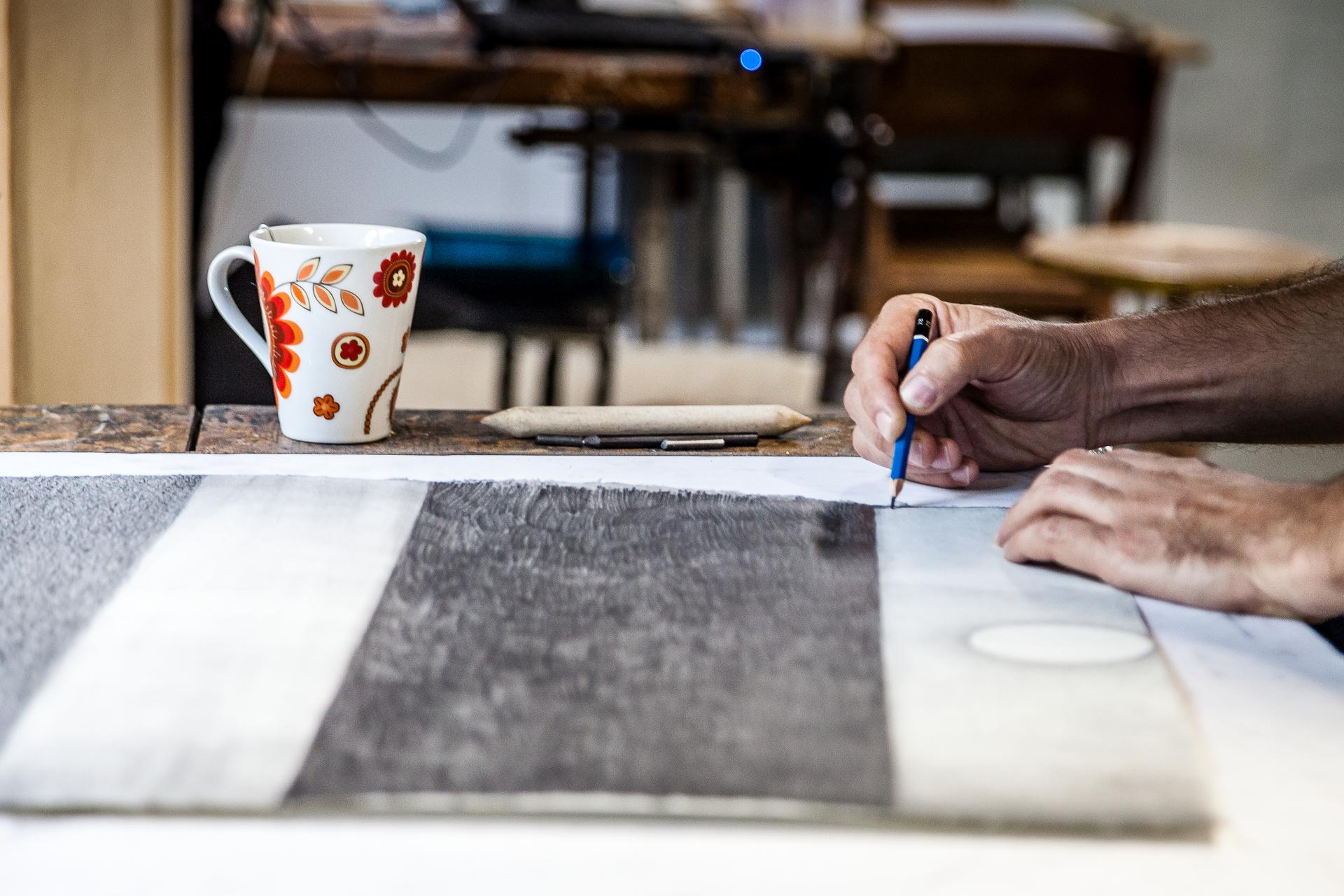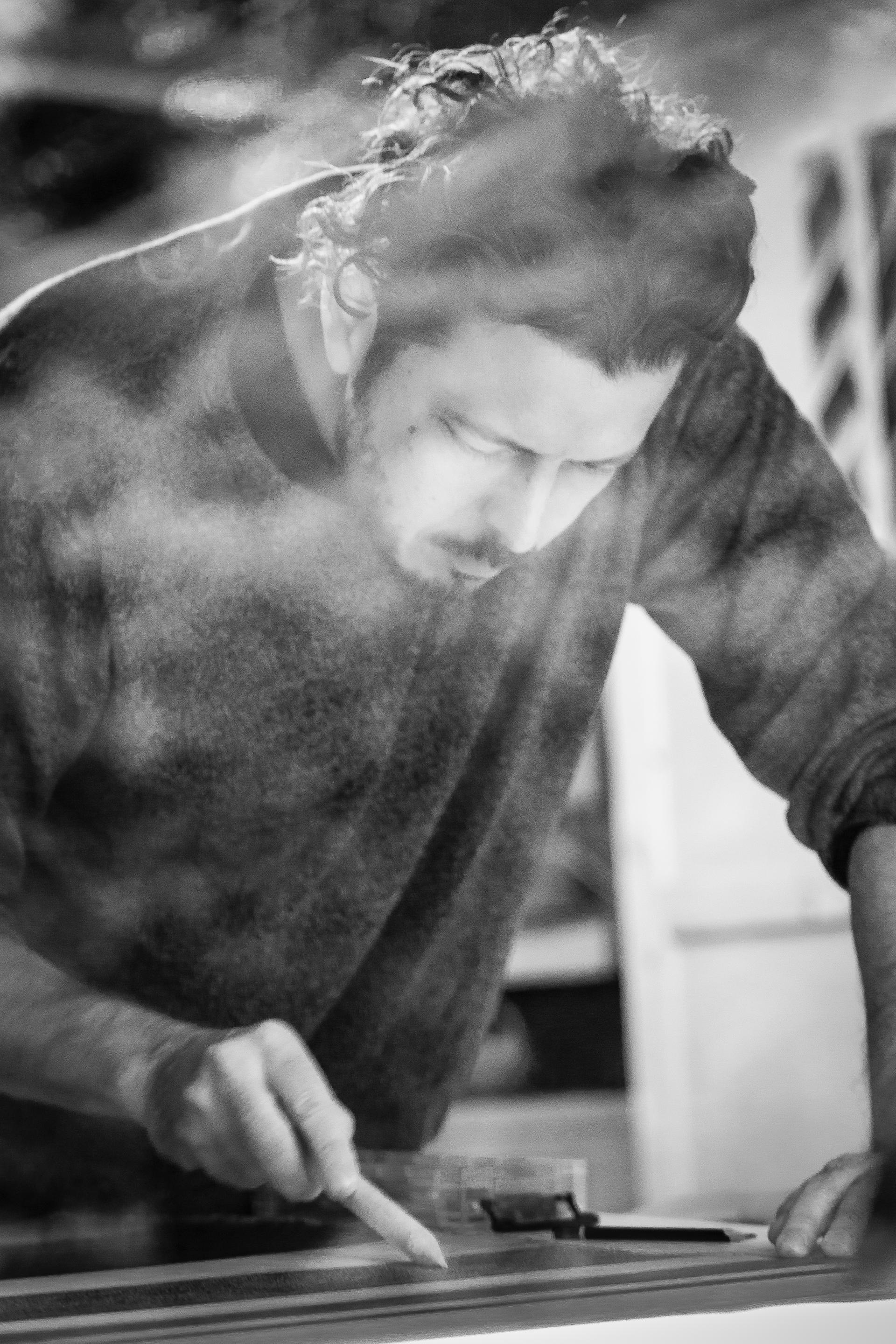Alex Yudzon
As an immigrant I am both observer and participant
At the Est-Nord-Est artists’ presentation, each image projected by Alex Yudzon is greeted by exclamations of surprise and delight. He is showing photographs taken during a ten-day road trip travelling east from Est-Nord-Est, along the shore of the St. Lawrence River, around the Gaspé Peninsula, then into New Brunswick and Nova Scotia before returning to Saint-Jean-Port-Joli. Not your usual holiday shots: the immediately captivating black-and-white photographs show the contents of hotel rooms – beds, couches, cushions, desks, lamps, bar fridges, art, dishes, fly swatters, plants, and so on – rearranged into unlikely and precarious relationships with each other with the confines of the room.
Sometimes these things are extravagantly piled up to the ceiling, sometimes pushing out of a closet door, sometimes reverently centred on the bed, sometimes lined up and stacked as if waiting for who knows what; nothing except what was already in the room when Yudzon walked in the door was used in these “furniture sculptures.” Other self-imposed restrictions were that only available lighting and the flash on his camera were allowed for illumination, and everything had to be back in its original position by the time he shut the door behind him and continued on his road trip.
Each photograph is animated with great potential, fraught with possibility, and brimming with hints at a strange and wonderful and unimaginable past. Always a little tongue in cheek – and certainly cheeky – they are also deadpan, seriously engaged, and otherworldly. Yudzon attributes this simultaneous stance to being an immigrant, perpetually “both a participant and observer.” As an artist, he has cultivated and maintained this “anthropological mind-set,” along with a preoccupation with home and the meaning of “homeland.”
Yudzon examines how we construct home, even temporarily in a hotel room, and re-create past worlds as an ideal of a “homeland,” through four separate bodies of work that he engages with simultaneously. He has begun a series of drawings – hypothetically to replace the generic art so often hanging on the walls of hotel rooms – featuring little cars, headlights, and illuminated night-time landscapes. Their cinematic, surrealistic quality could well accompany the curious displacement and wary appraisal that one always feels upon entering a hotel room – roads going everywhere and nowhere.
“Even the temporary becomes personal,” says Yudzon. “People need to create spaces where they have safety, beauty and shelter.” The temporary certainly became personal in the old Est-Nord-Est building. Since 1992, the succession of artists in residence at Est-Nord-Est had transformed their studio spaces over the course of their stays, and, in returning them to white-walled blank slates for the next resident, left behind ever more stuff in the hallways and shared spaces. Yudzon mined the site for ideas and material before the spaces were cleared out and the building demolished to make room for the new Est-Nord-Est. He showed the results of this scavenging – projecting lush photographs of some of the items that he collected and placed in local sites, sidestepping expected contexts to hint at suspended narratives and strange occurrences. Left-over Milky Way playing cards lie in the foam of the St. Lawrence, joker in the middle; a broken plaster sculpture of a hand, with only the middle finger remaining, balances on a Jenga-like stack of ladyfinger cookies. All so seductively curious. One can’t help but share with Yudzon his anthropological mind-set – to wonder at the strangeness of the almost familiar.
Biography
Visual artist, born 1977 in Moscow, Russia. I immigrated from Russia to the US at the age of 8. Arriving in America during the waning years of the Cold War proved challenging. On the one hand, the United States possessed an exciting abundance of everything that Russia lacked, on the other I felt socially isolated in a culture I didn’t understand. These contradictions left me feeling that the world was inherently unreliable. Coming from a country with a rich iconophilic heritage, painting quickly became an invaluable outlet. The visual language of painting and my experience as an immigrant, the ineluctable sense that our world of plentitude masks a deep existential uncertainty, are the biggest influences on my work. As a result, I have developed an interdisciplinary approach to photography, one that incorporates sculpture, painting, site specific installation and ephemerality. Whether working in the studio creating meticulous, labor intensive tableaus that blur the line between painting and photography or constructing site specific installations in hotel rooms or remote environments, my work questions the role that memory, place and history play in constructing our sense of who we are.
Discover
Newsletter
Keep up to date with the latest news!







